The front-lobed basilisk is unmistakable thanks to its emerald green to blue coloration and impressive head feather.
Characteristics
What does the frontal lobe basilisk look like?
The forehead lobed basilisk belongs to the reptiles and there to the iguana family and to the basilisk genus. Its typical feature is the small frontal lobe and the large occipital lobe. This is also called the headsail because it protrudes backward from the head like a sail. Crests of skin run down the middle of the back from the head to the tail. They are supported by bone braces and can grow up to two inches in height.
Their physique resembles that of an iguana. The animals are up to 70 centimeters long, some even longer. However, two-thirds of this is made up of the tail. It reaches a length of 50 to 55 centimeters. The four legs are strong. Like all critters, front-lobed basilisks molt regularly. The skin scales of the frontal-lobed basilisk are colored emerald green, dark green, or blue-green. They are a little lighter on the belly side and have yellow to bluish speckles on their backs.
In females, the skin crests on the back and the frontal lobe are much less pronounced, and the occipital lobe is also much smaller than in males. However, these differences between males and females only become apparent at the age of seven to twelve months. Before that, the animals can hardly be distinguished.
Where do Frontal Basilisks live?

Forehead lobed basilisks are found only in Central America. The main areas of distribution are the countries of Honduras, Nicaragua, Costa Rica, and Panama. Forehead lobed basilisks are tropical dwellers. They live in shady rainforests and wetlands up to 25 meters above sea level. There they stay mainly in trees. It is important that the trees are near bodies of water. The animals are rarely found on the ground.
What types of basilisks are there?
There are five different basilisk species in tropical Central and South America. In addition to the frontal lobed basilisk, these are the helmeted basilisk, which occurs in Central America, Colombia, and Venezuela. The Ecuadorian basilisk lives from Costa Rica to western Colombia and Ecuador. The crowned basilisk inhabits the forests from southeastern Mexico to Nicaragua, the striped basilisk lives from southern Mexico to Colombia.
How old do Frontal Basilisks get?
In captivity, frontal lobed basilisks can live up to 15 years with good care. In nature, they usually die much earlier, probably at the age of eight. Females generally live shorter lives than males.
Behave
How do frontal lobe basilisks live?
Forehead-lobed basilisks are very impressive: their iridescent coloring, dorsal crest, and forehead and head lobes make them look like miniature dragons. Thanks to their toes and claws, the animals are excellent at climbing trees. They also move skillfully on the ground and run at speeds of up to seven kilometers per hour. However, they are also excellent swimmers and dive well.
It is quite unusual that they can even walk on water for a short time. This is possible because their toes are widened by a fringe of skin. They also run very quickly on their hind legs and only touch the water surface very briefly. Frontal-lobed basilisks are diurnal animals. At night they sleep on thin twigs over water, where they are better protected from snakes. In case of danger, they jump into the water and dive to the bottom.
Friends and foes of the frontal-lobed basilisk
The enemies of the frontal lobed basilisk are mainly snakes. If they feel threatened, they straighten up and run away on their hind legs at lightning speed.
How do frontal lobed basilisks reproduce?
The mating season for forehead basilisks is all year round. After mating, the eggs continue to develop in the mother’s abdomen for 40 to 45 days. Then the female lays about 15 eggs, from which the young hatch after 60 to 75 days. The warmer it is, the faster the babies grow and the sooner they crawl out of the eggs.
Newly hatched frontal-lobed basilisks are about twelve centimeters long and weigh about two and a half grams. They molt for the first time after five to six weeks. They are adults and sexually mature at around two and a half years old.
Care

What Do Forehead Basilisks Eat?
Forehead Basilisks have a very varied diet. In addition to insects, snails, and fish, they also eat other small lizards. But they don’t despise blossoms and fruits either.
Forehead Basilisk Keeping
Forehead Basilisks are quite demanding. Because they are quite large and quite lively, they need a terrarium that is very large. The minimum dimensions are 150x80x180 centimeters. Because the animals come from the tropics, the enclosure must be well heated. During the day the temperature should be 28 to 30° Celsius, at night 20 to 25° Celsius.
Forehead Basilisks can be held in groups. One male and two to three females do well together. Two males together, on the other hand, do not get along. The terrarium is furnished with many branches and real plants. A pool of water is also part of it because basilisks like to swim.
Care plan for forehead lobed basilisks
In captivity, the animals are only fed every two days. They then get locusts, cockroaches, and maggots. Eight to twelve feed animals per week are sufficient.
